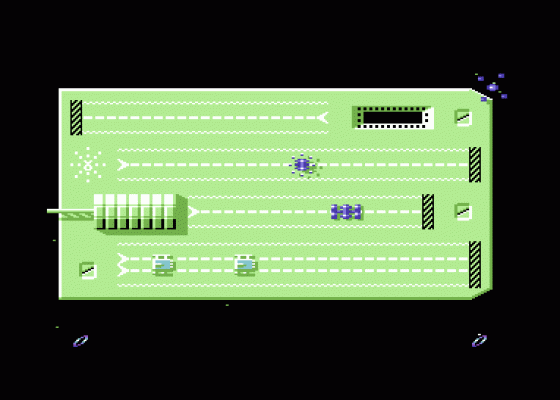
Commodore User
 1st September 1988
1st September 1988
Categories: Review: Software
Author: Bohdan Buciak
Publisher: Firebird
Machine: Commodore 64
Published in Commodore User #61
Intensity
For those of you who've been wondering what Andrew Braybrook's being doing since he left Hewson, here's the answer. He's been writing Intensity - and the wait has most definitely been worth it.
Intensity has a lot of the Braybrook trademarks to it - bas-relief graphics, swirling and gyrating nasties, good sound effects - but, surprisingly, it's not a fast reaction blaster, (incredulous gasp!) it doesn't scroll and there's no firing to be done.
Better get on with the story before you slope off in disgust. The objective is to rescue colonists from a space station which has been laid siege to by hordes of nasty aliens. The space station consists of five layers each with sixteen platforms - that makes 80 screens to complete. The scenario doesn't sound promising but the game's complexity makes up for it.

Your craft is a Skimmer which hovers above the surface of the platform. The Skimmer itself doesn't pick up colonists, it controls a Drone which, when placed in an appropriate position, attracts colonists, who then come up from their hidey-holes and make their plodding way towards it. By the way, the colonists are graphically disappointing, amounting to mere blobs.
When the required number of blobs, sorry, colonists are safely aboard the Drone, you guide it to the flashing Exit marker and, hey presto, that platform is complete. Only 79 more to go.
Here's how it all works. The Skimmer moves the Drone by placing itself on the spot it wants the drone to go to. Pressing the Fire button makes the Drone come to the Skimmer. But the Skimmer must move before the Drone arrives because, if they collide, both of them go up in smoke. Moving the Drone can be done any number of times in order to choose the best positions to pick up colonists as they emerge.
On later levels, gathering colonists becomes more difficult due to the gaps in the terrain. But bridges can be extended over gaps by landing the Drone on top of a bridge control arrow. The bridge will automatically retract after use.
As I was saying, the Exit marker flashes after five, ten or fifteen colonists have been collected. If you exit with five, you're transported to an easier platform on an adjacent layer (that layer's Greek letter will be indicated on the Exit marker).
If you ignore that and wait to exit after collecting the colonists, you're transported to a more difficult platform on the other adjacent layer. After fifteen colonists, you stay on the same layer but move up one platform towards the shuttle. But as you get closer to the shuttle, transfer paths to others become increasingly rare.
So it makes sense to collect fifteen colonists before you exit, despite the greater risks from aliens. Not just because you stay on the same layer but because you have the chance of collecting one 'R' or Resource Unit for every colonist collected. R's are worth collecting because they enable you to buy more Skimmers and Drones.
Skimmers and Drones come in three types - gamma, beta and alpha - which increase in terms of speed and hover height. Both are important assets. And, of course, you need more money to buy the better ones. Added to that is the fact that better class equipment isn't available immediately - you have to wait a certain number of 'time segments' before they become ready for use.
Anyway, back to speed and hover height. Speed is crucial because the only way your Skimmer can zap aliens is to bump into them. It's also got to be pretty agile to catch the R's whenever they appear: Aliens zap them if they get there first. Even if they don't, R's burn up of their own accord after a short time.
Hover height is also important because various elements of the terrain are at different heights. Of course, you get no impression of height because the view is a downward one.
I enjoyed Intensity very much once I'd got over the initial disappointment of not having anything to fire at. It's a big and complex game that's well worth the time and effort involved in getting to know it well. My only real gripe is the use of Greek letters on the Exits - it's almost impossible to make them out.
Apart from that, this is another impressive Braybrook offering, and an indication of the progress his games are making.
Mutating Aliens
These start out as harmless little spores floating in towards the platform surface. When a spore lands, it becomes a Stalker, it then gets a little nastier and becomes a Podule, then a Tracker and finally a Nuclon. Nuclons are Stalkers which have grabbed a colonist - you can see the colonist in the middle of the gyrating nasty. This is when they explode, but they still carry the colonist's desire to get to the Drone. At this point, contact with either the Drone or Skimmer will cause them to be destroyed or downgraded. Pretty nasty stuff, eh?
In fact, the only good thing about all this mutating is that your score more points if you zap an alien in a higher mutated form. Similarly, you get more points for collecting colonists on higher graded levels.












